Seahorses Types, Locations, and Tips for Scuba Divers
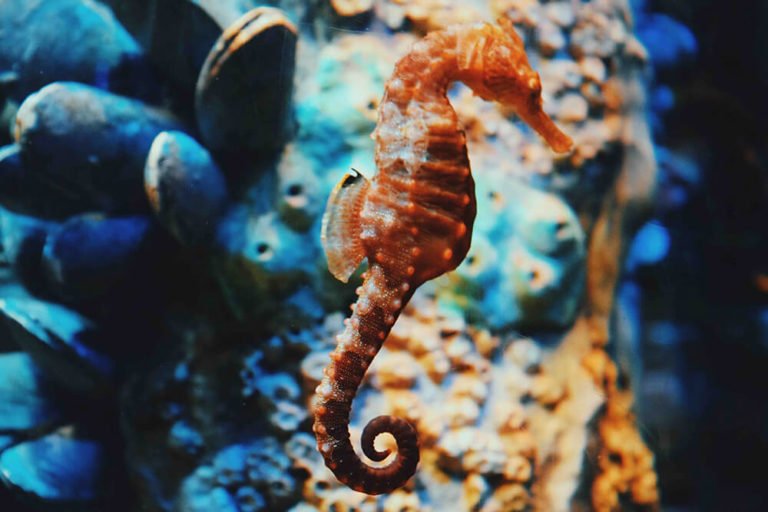
Floating in undersea grass beds, propelled by tiny, delicate fins, you’ll find one of nature’s most fascinating creatures—the seahorse. With over 50 species of this striking creature, it’s no wonder scientists keep learning more about them every day.
They’re known for their horse-like snouts and long, curled tails, but there’s more to these fish than meets the eye. (And yes—seahorses are classified as fish! They breathe through gills, leading scientists to place them in the “bony fish” category). From their mating rituals to their survival skills, seahorses’ behaviors are incredibly unique.
Here are some of the most encountered species:
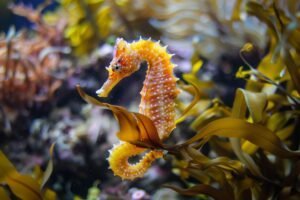
- Common Seahorse (Hippocampus kuda)
The Common Seahorse, also known as the Estuary Seahorse, is found in shallow waters of the Indo-Pacific region. These seahorses can vary in color from yellow to brown and are often spotted in seagrass beds and mangroves.
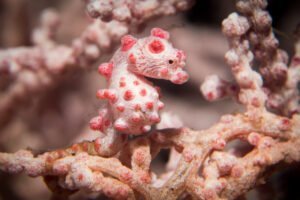
- Pygmy Seahorse (Hippocampus bargibanti)
The Pygmy Seahorse is one of the smallest seahorse species, measuring just over a centimeter in length. These tiny creatures are masters of camouflage, blending in perfectly with the gorgonian corals they inhabit. They are primarily found in the Coral Triangle, including Indonesia, Papua New Guinea, and the Philippines.
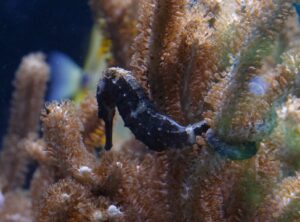
- Pot-bellied Seahorse (Hippocampus abdominalis)
Native to the colder waters of southern Australia and New Zealand, the Pot-bellied Seahorse is one of the largest species, reaching up to 35 centimeters in length. These seahorses are known for their prominent, rounded bellies.
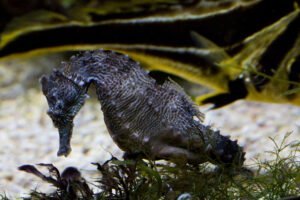
- Lined Seahorse (Hippocampus erectus)
The Lined Seahorse is one of the most widespread species, found along the Atlantic coasts of North, Central, and South America. They are known for their distinctive pattern of lines and spots and can be seen in a variety of habitats, including seagrass beds, coral reefs, and mangroves.
Next time you slip on your wetsuit, keep an eye out for these dainty, gentle fish!
QUICK FACTS ABOUT SEAHORSES
- The Latin word for seahorse is “hippocampus,” which means “horse caterpillar.”
- Seahorses have excellent eyesight. Their eyes can act independently of one another, allowing them to look in two different directions at once.
- Seahorses use their thin snouts to find and suction up food.
- They mainly feed on plankton, as well as the occasional tiny crustacean or fish.
- Seahorses don’t have scales, instead they have bony exoskeletons.
- Seahorses can quickly change color in order to camouflage themselves.
- They use their snake-like tails to grasp grasses and corals in order to avoid floating away in the current.
- Seahorses are extremely light-sensitive and can get agitated if divers shine bright lights on them.
SEAHORSE MATING + REPRODUCTION
Seahorses are one of the few creatures that mate for life. In fact, they show their unwavering dedication to their partners with a dramatic mating ritual. The male and female pair approach each other, rapidly changing color, and rotate around an object together, sometimes for hours.
Even more fascinating? Female seahorses lay their eggs on a male seahorses abdomen, impregnating him with their young. This makes seahorses the only species in which the male fully carries the young. These males can give birth up to 1000 babies at once! But once these juveniles are born, they must learn to survive on their own. They often clump together in small groups, floating along in the current with their tails intertwined.
BEST PLACES TO SEE SEAHORSES
Seahorses are distributed across the world’s oceans, but they are most commonly found in tropical and temperate waters. Here are some regions where you are most likely to encounter seahorses:
- Southeast Asia: The Coral Triangle, including Indonesia, the Philippines, and Papua New Guinea, is a hotspot for seahorse diversity, particularly for species like the Pygmy Seahorse.
- Australia and New Zealand: The southern coasts of Australia and New Zealand are home to the Pot-bellied Seahorse and several other species.
- The Caribbean and Gulf of Mexico: These warm, shallow waters are ideal for species like the Dwarf Seahorse and Lined Seahorse.
- The Mediterranean and Eastern Atlantic: Seahorses like the Long-snouted Seahorse can be found in the coastal waters of Europe and the Mediterranean Sea.
Seahorses are fascinating creatures that add a touch of magic to any scuba diving adventure. By understanding the different types of seahorses, knowing where to find them, and following the right diving techniques, you can increase your chances of encountering these wonderful animals in the wild. Whether you’re diving in the Coral Triangle, exploring the Caribbean, or venturing into the Mediterranean, keep an eye out for these captivating fish and enjoy the thrill of discovering them in their natural habitat.
HOW TO SPOT SEAHORSES
Seahorses love to hang out in grass beds, wrapping their long tails around the weeds to hold themselves upright. They often take on the colors of the corals, grass and sea elements they’re hiding in, so look closely to spot them. Their twisty tails and fluttering dorsal fins often give them away.
Here are some tips to increase your chances of spotting these elusive creatures:
- Focus on Their Habitat
Seahorses are often found in specific habitats such as seagrass beds, coral reefs, and mangroves. Keep an eye out for these environments, especially in calm, shallow waters. - Look for Camouflage
Seahorses are masters of disguise, often blending in with their surroundings. Slow down and take your time when exploring potential habitats. Look for subtle movements or shapes that stand out from the background. - Be Patient and Observant
Seahorses are not always easy to spot, even in areas where they are known to live. Patience is key. Move slowly and methodically through their habitat, and don’t be discouraged if you don’t see one right away. - Use a Dive Light
A dive light can help you spot seahorses that might be hiding in the shadows or under ledges. The light can also enhance the colors of their surroundings, making it easier to distinguish them from the background.
SEAHORSE ENDANGERMENT
As magical as seahorses may seem, the truth is they’re in trouble. Large-scale harvesting of seahorses for souvenirs, medicine and even aquariums is making it difficult for the species to thrive. Not to mention, their close relationship with coral reefs makes them extremely susceptible to pollution.
WHAT YOU CAN DO
Do your best not to support seahorse harvesting by avoiding products made from seahorses. You should also ensure all of your dives are reef-friendly. From picking up trash underwater to wearing reef-safe sunscreen, there’s plenty you can do to keep our ocean clean (learn more here). The seahorses will thank you!
